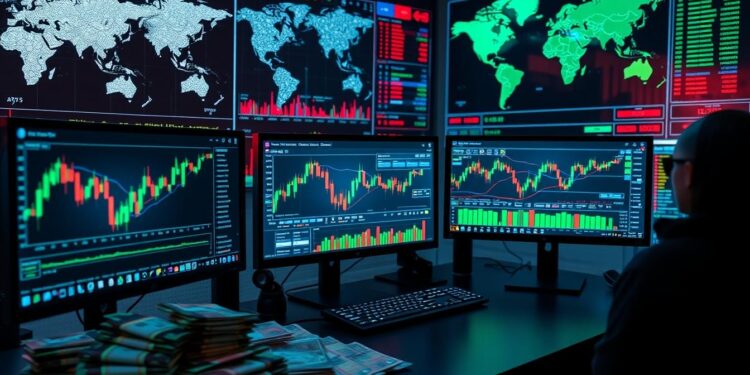Lost in the intricate world of finance? If you’re new to the forex landscape, the staggering $7.5 trillion daily trading volume can seem daunting. It’s a complex market, and beginners often stumble due to their lack of familiarity. But fear not! This guide aims to simplify forex trading for you.
In this journey, you’ll get to grips with currency pairs and market dynamics, and you’ll learn some valuable lessons on avoiding common pitfalls. Curious about the currency trading world? Let’s dive in!
Key Insights
Forex trading is all about buying and selling currency pairs. The market buzzes with activity 24 hours, five days a week, boasting a hefty $7.5 trillion in daily transactions. Among the most traded are major currency pairs like EUR/USD. Success here hinges on robust risk management and a solid understanding of both market analysis and trading strategies.
Decoding the Global Currency Market
The forex market, often dubbed the global currency market, is colossal, with daily trades exceeding $6 trillion. This scale dwarfs other financial markets, and there’s plenty more to discover about this massive trading arena.
A Trillion-Dollar Day in Forex Trading
In April 2024, the New York Federal Reserve noted that daily trading volume surpassed $1.165 trillion. Such figures depict a market where transactions are swift and even large-scale trades are executed promptly.
Round-the-Clock Trading
Forex operates around the clock, five days a week, accommodating traders across different time zones and financial hubs. This 24/5 schedule reflects the constant demand for currency exchanges globally.
Major Hubs and Trading Sessions
The forex market is segmented into four primary trading sessions: Sydney, Tokyo, London, and New York. Some sessions overlap, leading to heightened activity, particularly when both London and New York trading floors are open.
What Makes Forex Trading Tick
At its core, forex trading revolves around the exchange of currency pairs on a global scale. It runs continuously from Monday to Friday, trading volumes eclipsing those of stock markets by a wide margin.
The ABCs of Currency Pairs
Currency pairs form the backbone of forex trading. They illustrate the value of one currency against another—say, the EUR/USD indicates how many US dollars per euro. Traders aim to profit by predicting changes in these values.
How Buying and Selling Work
Engaging in forex means trading one currency for another. Spot rates facilitate immediate trades, whereas forward contracts allow for future transactions. The liquidity of a currency is often reflected in the spread, which varies based on transaction size and timing.
Who’s Trading in the Forex World
The forex realm is teeming with diverse traders. Dominating the landscape, banks handle about two-thirds of trading activities. Other influential players include financial institutions, multinational corporations, hedge funds, and individual traders, each with unique trading strategies.
The Crux of Currency Exchanges
Currency exchange is fundamental in forex. Whenever you travel and swap your money, you encounter it firsthand. The exchange rate, determining how much one currency is worth in another, fluctuates due to economic shifts and global events.
Major Players Steering the Market
The forex market’s sheer size of $6.6 trillion in daily trading volume is evidence of its complexity. Banks, both commercial and central, play pivotal roles, setting currency prices and influencing market trends.
Dive Into Essential Forex Vocabulary
The forex trading world has a language of its own. It’s important to grasp essential terms like leverage, spread, pip, and lot, as they define the mechanics of trading and help traders make informed decisions.
Unveiling Currency Pairs and Quotes
When trading, understanding currency pairs is imperative. Major pairs have greater liquidity and tighter spreads, making them appealing to traders, while minor and exotic pairs, though less liquid, can present unique opportunities.
The Path to Profits in Forex
Making money in forex hinges on predicting currency value changes accurately. From scalping to swing trading, various styles offer diverse approaches for traders seeking to capitalize on market fluctuations.
Tools and Platforms for the Modern Trader
Today’s traders have a wealth of platforms and tools at their disposal. Advanced software like MetaTrader 4 enhances the trading experience by offering demo accounts and rich analytical tools for informed decision-making.
Crafting a Trading Plan
A well-crafted trading plan is your roadmap to success. It involves setting clear goals, assessing risk tolerance, and defining entry and exit strategies to navigate the market effectively.
Leveraging the Power of Forex
Leverage allows traders to amplify their positions and potential returns. Though it can enhance profits, improper use can lead to significant losses, underscoring the need for careful management.
Decoding Market Analysis
Astute market analysis is crucial for effective trading. Combining technical, fundamental, and sentiment analysis provides a comprehensive view and enhances predictive accuracy.
Avoiding Common Missteps
New traders often fall into pitfalls like overtrading or neglecting risk controls. By recognizing and avoiding these errors, traders can better position themselves for success.
Embark on Your Forex Journey
Launching your forex career requires choosing the right broker, practicing through demo accounts, and deeply understanding the market. With persistence and prudent risk management, you can carve out success in this vibrant trading arena.
In Closing
Navigating the forex market, a $6 trillion daily trading behemoth, offers boundless opportunities for skilled traders. By continuously learning, utilizing demo accounts, and rigorously managing risks, newcomers can thrive in this dynamic space, honing their skills and achieving financial success.


















